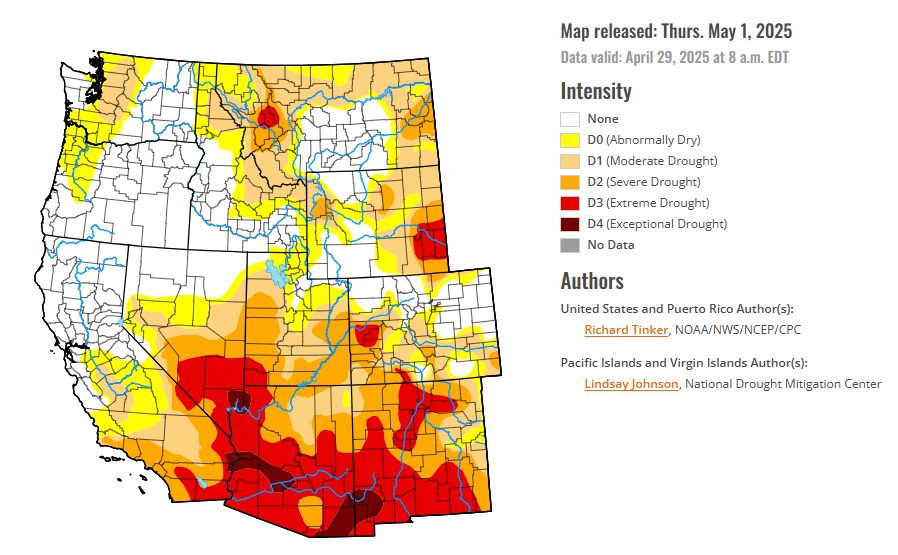- One-third of the U.S. remains free of drought as of May 1.
- Moderate to severe drought persists in Colorado River Basin states.
- Arizona and New Mexico see intensifying extreme drought.
- Conditions remain stable in California, Nevada, and Utah.
Saturday, May 3, 2025 — According to the U.S. Drought Monitor report released on May 1, 2025 , large swaths of the central and eastern United States experienced heavy rainfall, bringing welcome drought relief. However, states in the West, particularly those in the Colorado River Basin, received little or no rain. Rainfall was negligible (several tenths of an inch at best) in most areas from the Rockies westward, leading to either persistence or worsening of drought conditions across the region.
, large swaths of the central and eastern United States experienced heavy rainfall, bringing welcome drought relief. However, states in the West, particularly those in the Colorado River Basin, received little or no rain. Rainfall was negligible (several tenths of an inch at best) in most areas from the Rockies westward, leading to either persistence or worsening of drought conditions across the region.
Nationally, 32.6% of the United States is currently experiencing no drought, a slight drop from 34.23% last week. Meanwhile, 51.8% of the nation remains under moderate drought or worse, with 16.34% in extreme drought and 1.88% classified in the most severe category—exceptional drought.
Arizona: Drought Holds Steady, But Heat Looms.
Arizona remained mostly dry during the past week, with no significant precipitation reported. The Drought Monitor described the state’s dryness as “more climatologically seasonable,” meaning it aligns with typical late-spring patterns. Conditions were unchanged from last week, but as temperatures rise, moisture stress could intensify, especially in central and southern counties. Severe and extreme drought remain entrenched in the southern half of the state.
California: No Change, but Southern Regions Remain Dry.
California experienced another dry week, and drought coverage or intensity remained stable. The most affected areas are still located in the southern and inland regions. Northern California continues to benefit from earlier wet conditions, avoiding further degradation. The report again used the phrase “more climatologically seasonable” to describe the lack of change in statewide conditions.
Colorado: Drought Expands in the Southeast.
Colorado saw mixed patterns. While parts of the state received rain, southeastern and central Colorado experienced worsening conditions. According to the report, the dry week led to deterioration across southwestern Kansas, southeastern Colorado, and much of the central tier of Colorado. Moderate drought expanded slightly, and severe drought remained active in the southern tier. Subpar snowpack runoff continues to aggravate conditions in dry areas.
Nevada: Status Quo Amid Spring Dryness.
Nevada’s drought map remained unchanged this week. Most of the state continues to experience abnormally dry to moderately dry conditions. With no significant rainfall reported, surface moisture levels remain suboptimal. Although conditions did not worsen, they also showed no signs of improvement.
New Mexico: Extreme Drought Expands.
New Mexico experienced a concerning shift in drought intensity. The Drought Monitor reported that “surface moisture depletion… increasingly obvious across several areas in New Mexico, leading to a significant increase in D3 (extreme drought) coverage.” Only a narrow corridor in east-central New Mexico received notable rainfall. The state now has one of the highest shares of extreme drought among the Colorado River Basin states, with the southern region showing increasing vulnerability.
Utah: Stable for Now, But Snowpack Remains an Issue.
Utah experienced no changes in drought conditions this week. However, long-term concerns persist. Snowpack levels remain lower than average, and the last two months have brought below-normal precipitation in several parts of the state. Although the drought map remained static, soil moisture and runoff levels continue to be closely monitored. In late April, Utah Gov. Spencer J. Cox issued an executive order declaring a state of emergency in 17 counties due to worsening drought conditions. The affected counties include Washington, Iron, San Juan, Kane, Juab, Emery, Grand, Beaver, Garfield, Piute, Millard, Tooele, Uintah, Carbon, Sevier, Sanpete, and Wayne.
Wyoming: Some Relief, but Not Enough.
Wyoming performed better than many of its western neighbors. The Drought Monitor noted that “widespread heavy rains were noted… in Wyoming,” which helped reduce drought severity in the north and west. However, central and southern parts of the state continue to experience dryness. Moderate and severe drought persist in several southern counties.
Drought Categories Compared to Last Week.
Based on the official data table released with the May 1 report, the nation saw a slight uptick in drought severity compared to the previous week:
| Category | Last Week | This Week | Change |
|---|---|---|---|
| No Drought | 34.23% | 32.60% | -1.63% |
| Abnormally Dry or Worse (D0-D4) | 65.77% | 67.40% | +1.63% |
| Moderate Drought or Worse (D1-D4) | 50.65% | 51.80% | +1.15% |
| Severe Drought or Worse (D2-D4) | 31.87% | 31.83% | -0.04% |
| Extreme Drought or Worse (D3-D4) | 15.00% | 16.34% | +1.34% |
| Exceptional Drought (D4) | 1.88% | 1.88% | No Change |
The national Drought Severity and Coverage Index increased from 165 to 169.
Outlook: Storms Bypass the West.
Looking ahead, forecasts through May 5 show the potential for heavy rain in the central and eastern United States, including Texas and parts of the Southeast. However, minimal precipitation is expected in the northern Rockies, the Pacific Coast, and much of the Southwest. According to the Climate Prediction Center’s 6–10 day outlook, the Southwest may see improved chances for rain. Until that happens, much of the Colorado River Basin will continue relying on already diminished snowpack and limited water storage.


The forecast has called for scattered rains for about the last 3 days, and 2 days into the future. These little bursts of rain are extremely welcome but a good, solid, rainy, season is needed here. The entire Colorado river basin area needs replenishing.
There are so many things we do to, and for, and in the name of ‘water’. It’s conservable, it can be harvested, recycled and so much more. I’d like it if we could create rain ‘as needed’, maybe one day science will work it out.